Hitomi, An Ambitious Endeavor Cut Short
August 19, 2016
The Hitomi X-ray Observatory, designed to study extremely energetic astrophysical processes, was launched on February 17, 2016 and lost March 26, 2016. During its shorter-than-expected life it managed to obtain and transmit significant data about the motion of gas in the Perseus galaxy cluster.1 This is quite a feat for the Hitomi Team, which consists of over 200 members.
Galaxies vs. Galaxy Clusters
Our beautiful Milky Way is a single galaxy containing between 100 and 400 billion stars, enough gas to make more stars—billions more—and ten or more times that much mass, in the form of dark matter.2 Dark matter is matter that does not absorb, emit, or reflect electromagnetic radiation and has only been detected by its gravitational effect. This is one galaxy.
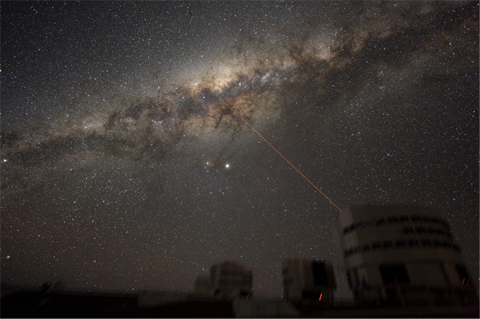
Our Milky Way. The laser points to our Milky Way's center.
Image Credit: ESO/Y. Beletsky - CC BY 3.0
A galaxy cluster contains hundreds to thousands of galaxies surrounded by superheated gas. Galaxy clusters are the largest known objects in the Universe that are held together by gravity. Scientists look to galaxy clusters to gain information on dark matter and dark energy.
What We Know About Galaxy Clusters
The superheated gas that surrounds the galaxies in a cluster moves rapidly, and is denser near the center of the galaxy cluster. Here collisions between gas particles is likely, and causes greater emitted X-ray radiation.3 NASA’s Chandra X-Ray Observatory has already learned much about the Perseus galaxy cluster, which is 250 million light years (2.366 ✕ 1024 m) from Earth. Scientists have found the existence of a black hole in its center, the formation of “bubbles” during releases of energy by the black hole that push the hot gases away, and even sound waves that are created when the bubble pushes away the surrounding gas creating a pressure wave in the gas.3
An interesting observation the Chandra X-ray Observatory made is a spike of X-ray energies shown circled in the following image of the Perseus galaxy cluster. This spike in observed X-ray energies was confirmed by other satellites and in over 70 other galaxy clusters. None of the past satellites were sensitive enough though to assure that this measured spike was not due to normal matter undergoing extreme conditions.—the Hitomi satellite had extremely sensitive equipment on it.
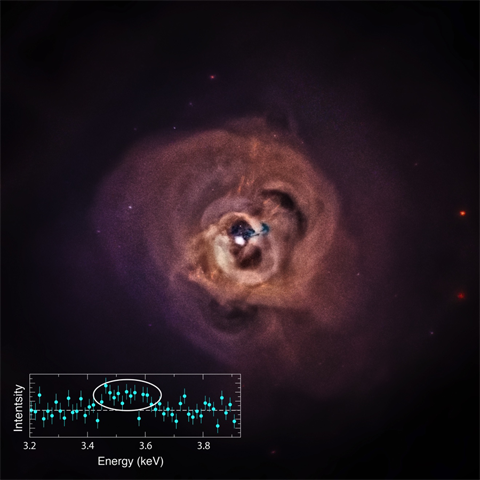
Center of Perseus galaxy cluster with energies measured in keV (kilo electron volts). The bright spot in the middle is a black hole. X-rays are emitted in jets as charged particles appear to spiral inward. The dark areas called “bubbles” are filled with highly energetic particles that push the gaseous material aside, creating a sound wave 57 octaves below middle C. The bubbles are created by energy released by the black hole.
Image Credit: NASA/CXC/SAO
Another question scientists have is: why don’t the large volumes of gas around the galaxies cool and form new stars? The Chandra X-ray Observatory and others have collected evidence which suggests that turbulence prevents this from happening. They observed that, as the black holes spew forth streams of energetic particles, cavities are formed in the surrounding gas (bubbles). It is believed that the gas can remain hot by energy transferred at the boundary between the cavity and the gas. As particles interact at the boundary, the motion of the particles should become turbulent and this turbulence transfers energy back to the gas, keeping it hot. The sound wave created would also transfer some energy. The two images below suggest turbulence around the galaxy clusters.
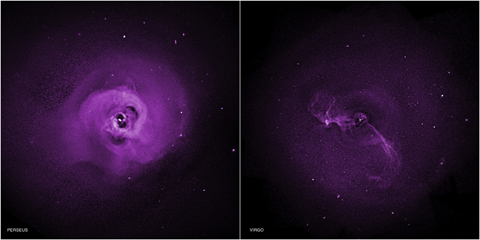
Images suggesting turbulence near dark cavities around centers of two different galaxy clusters.
Image Credit: NASA/CXC/SAO
The JAXA Hitomi X-ray Observatory
The Hitomi X-ray Observatory stood in a class of its own. It had upon it a series of instruments that together could detect a range from X-rays to gamma rays, with energies from 0.3 keV to 600 keV. Unfortunately, shortly after launch the Hitomi X-ray Observatory started spinning out of control and broke up, apparently due to centrifugal force. Before it did, however, the scientists in charge got some data. They were not done with the calibration of the instruments, but their data is good and may be the only data like it until the next X-ray observatory of such caliber (Athena) gets launched sometime in 2028.
One of the instruments on the Hitomi satellite was a soft X-ray spectrometer (SXS), which is a calorimeter cooled to near absolute zero that picks up light at energies between 0.3 keV and 12 keV. In this spectrometer, when an X-ray strikes a pixel, the pixel heats up. The device detects the amount of heating, which is directly related to the energy carried by the X-ray. This instrument imaged a portion of the Perseus Cluster for roughly 2 2/3 days (230 thousand seconds), and it did so with a resolution as good as they expected, and with 20 times better resolution than previous measurements.
What did they look at? The hot gas around the center of Perseus. Their goal was to measure the velocity of the gas and determine the turbulence as well. They did this by looking at signature spectral lines—electromagnetic energy of a certain frequency, emitted during electron transitions—from ionized iron atoms, as well as chromium, manganese, and nickel, but the strongest lines were from iron, and these were the most useful in their attempt at calibrating the spectrometer.
An iron atom at rest emits spectral lines when its outer electron goes from a higher energy level to a lower one. In this hot gas (more than 50 million ˚C) there are few outer electrons on the iron atoms: most have been removed due to the high temperatures, knocked away by collisions with other fast-moving atoms. Occasionally, one or two electrons get bound to an iron atom and fall to a lower level, emitting a specific frequency and energy of electromagnetic radiation. The ones of interest happen to be in the X-ray region. If the iron atom is moving toward the detector, that frequency and energy gets shifted to higher values, in a way proportional to the velocity of the atom. If it is moving away from the detector, it gets shifted to lower values. When a bunch of particles with a range of velocities emit the same characteristic frequency, a range of frequencies and energies are observed and a broader spectral component is measured. This is known as Doppler broadening. From the width of the broadened line a range of velocities of the emitting particles can be calculated. This shift in frequencies is like when a police car is approaching an observer standing on the side of the road, the frequency of sound produced by the car increases, but as it moves away it decreases. Watch the video below to learn more about the Doppler effect.
Hitomi, using the soft x-ray spectrometer, collected the data shown in the spectral image below. The red line is the previous best data collected by the Suzaku satellite. Hitomi’s spectrometer was 30% more sensitive.
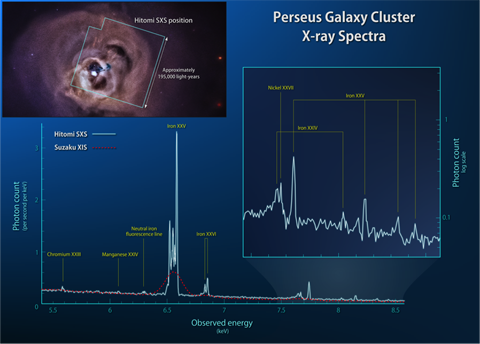
Hitomi's soft X-ray spectrometer data. The red line is the data previously collected by the Suzaku satellite.
Image Credit: NASA's Goddard Spaceflight Center
Hitomi’s data on the core of the Perseus galaxy cluster showed a velocity dispersion of 164 ± 10 km/s (≈ 367,000 ± 22,000 mi/h). A velocity dispersion is the statistical spread of velocities about the average velocity. This is basically the velocity of the turbulence along the line of sight, and is much lower than was expected.4 Although this is a high velocity and a broad range compared to everyday speeds, it is in fact quite slow and calm for structures of such a large scale and forces as powerful as Perseus’ “bubbles”; the researchers call it “remarkably quiescent” in their report.1 They also note a change in the line of sight velocity of 150 ± 70 km/s across the 60 kiloparsecs image of Perseus’s core. The pressure of a gas is related to the speed of the gas particles, and hence its temperature. The hotter the gas, the faster the particles move, and the higher the pressure (force per unit area within the cloud). The researchers compared the pressure due to just the temperature of the cloud with what the measured velocity of turbulence would contribute and found that the pressure due to turbulence would only be about 4% that due purely to thermodynamical contributions. According to the researchers, the estimate of turbulence could be doubled by including shear forces. Still, the speed of the gas is much less than expected, the turbulence is much less than expected, and the data is generally surprising compared to previous data.
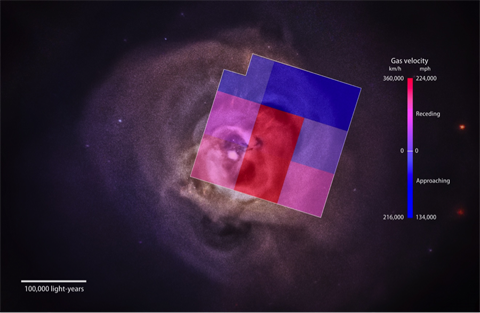
Velocity profile measured by Hitomi of the core of the galaxy cluster Perseus.
Image Credit: NASA Goddard and NASA/CXC/SAO/E. Bulbul, et al.
The research article describes different possible situations. If the observed dispersion is considered to be driven by turbulence on scales comparable with the size of the largest bubbles (about 20 to 30 kiloparsecs) then enough energy is transferred to the gas due to turbulence to prevent radiative cooling (emission of electromagnetic radiation) of the gas and halt formation of stars. This suggested scale for turbulence would also be in agreement with the inferred levels of X-ray brightness fluctuations from the surface.1 However, if the turbulence is isotropic (equal in all directions) then the energy transferred to the gas by turbulence would not be transferred far enough outward to balance the radiative cooling, and the core (which includes the hot gas) would cool and form stars at a greater rate than what is observed. Hence turbulence would need to be created throughout the core, and another mechanism would be needed to transport the energy from the bubble region to the surrounding gas of the core.1 They further note that the low level turbulence for the core region indicates it is difficult to generate and/or easy to damp.
The Hitomi team also noted that the level of turbulence they measured is enough to sustain the observed halo of radio synchrotron radiation created from ultrarelativistic electrons. Ultrarelativistic means moving very close to the speed of light in vacuum (three hundred million meters per second), and charged particles that are accelerating produce radiation.
Future Research
The unfortunate, unexpected, and all too soon death of the young Hitomi observatory did not stop it from leaving a legacy. The measurements of Hitomi are excellent, the best yet, and agree with other observations, but they leave scientists with revising their ideas on how energy propagates through the core of the Perseus cluster. In Hitomi’s wake come hopes for Athena – the new observatory currently being created. Athena is scheduled to be launched in 2028.
References and Resources
1. The Hitomi collaboration, The quiescent intracluster medium in the core of the Perseus cluster, Nat. Letter 535, 7610, 117–121 (07 July 2016)
http://www.nature.com/nature/journal/v535/n7610/full/nature18627.html
2. NASA
http://science.nasa.gov/astrophysics/focus-areas/what-are-galaxies/
3. NASA Chandra X-Ray Observatory
http://chandra.harvard.edu/photo/2003/perseus/
4. Japan Aerospace Exploration Administration (JAXA) - HITOMI
http://global.jaxa.jp/projects/sat/astro_h/
5. NASA/Hitomi
http://heasarc.gsfc.nasa.gov/docs/hitomi/
—H.M. Doss














